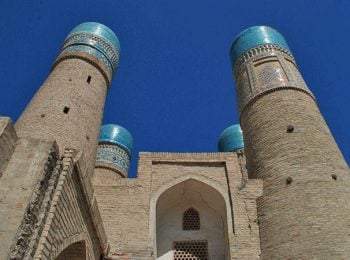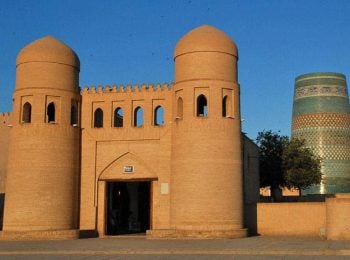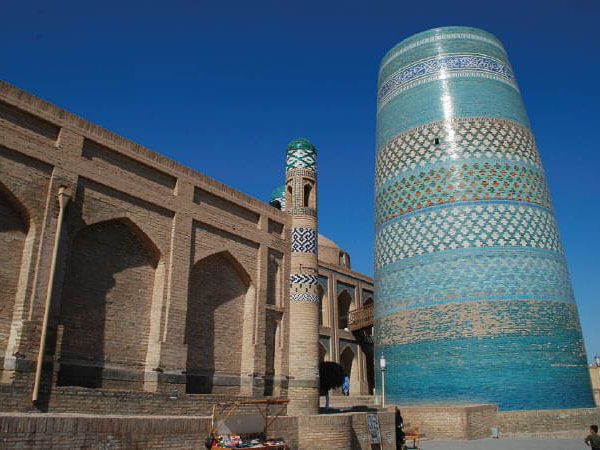Day 1 - Dushanbe
Arrive in Dushanbe. Depending on when you arrive there may be time to explore the city. Overnight Rumi Hotel or similar.
Day 2 - Gissar – Dushanbe
Exploration of Dushanbe. Visit the Museum of Antiquities, a great introduction to the diverse and complex cultures which once held sway in the region. Later we visit the town of Gissar, known for its fortress and interesting madrassahs dating back to the 16th century. Overnight Rumi Hotel or similar. (BL)
Day 4 - Istaravshan – Khojand
Drive over the Shakhristan Pass to the town of Istaravshan. We visit the craftsmens’ quarter with the blacksmiths’ workshops, then visit the fortress and blue domed Kok Gumbaz mosque, more reminiscent of Uzbekistan. From here continue to Khodjand, founded by Alexander the Great, where we visit the madrassah complex of Sheikh Muslihiddin and the Panjshanbe bazaar. Overnight Hotel Khujand Deluxe or similar. (BLD)
Day 6 - Samarkand
Take a high-speed train to the spectacular city of Samarkand. Upon arrival visit the museum to gain an understanding of the history of the region. Overnight Orient Star Hotel or similar. (B)
Day 7 - Samarkand
A full day exploring the marvellous sites of Samarkand, one of the most incredible Silk Road cities and with a wealth of monuments to explore. We visit the enormous Bibi Khanum Mosque, built by the wife of the Mongol ruler Timur, as well as the stunning Registan Square, one of Central Asia’s most iconic sites. We also visit the Shah-i Zinda complex of mausoleums, a stunning collection of buildings dating back to the 14th century that rivals the Registan for splendour, and also the observatory of Ulug Beg. Overnight Orient Star Hotel or similar. (B)
Days 8-9 - Bukhara
We take another high-speed train, to Bukhara. Bukhara is awash with breathtaking monuments and its historic centre is exceptionally well preserved, making a visit here like stepping back in time to the days when the Silk Road trade was at its height. We spend our time exploring this enchanting city and visiting its most important sites, including the Kalon Minaret, the Lyabi Hauz ensemble, the bazaars, the Ismail Somoni Mausoleum and one of our personal favourites, the Chor Minor mosque with its four blue domed minarets. And of course no visit to Bukhara would be complete without visiting the Ark, the vast fortress that was home to the Emirs for over a millennium. Bukhara is a spectacular city and we have enough time to enjoy its many delights without feeling rushed. Overnight Lyabi Khauz Hotel or similar. (B)
Day 11 - Khiva
Drive to Khiva. Enclosed by mud brick walls, the old part of Khiva, known as the Ichon Qala, has been virtually unchanged for centuries and is an open air museum packed full of intricately decorated minarets, mosques and madrassahs. We spend the day walking its narrow alleys and uncovering the best of its highlights including the Kalta Minor minaret, the Islam Khodja madrassah and the ark, where the khans of Khiva once lived. Overnight Orient Star Khiva or similar. (B)
Day 14 - Ashgabat
Drive to the capital Ashgabat, a fascinating city but very different from what you have already seen. We spend the rest of the day exploring the city with its striking and often bizarre collection of monuments, including Neutrality Arch, the Earthquake Monument and others as well as the ancient Parthian fortress of Nisa. Overnight Yyldyz Hotel or similar. (B)
Day 16 - Ashgabat
Transfer to the airport for departure. (B)
Please note that some people may be joining this trip in Tashkent, and ending in Uzbekistan, as part of our Jewels of Uzbekistan trip.
What's included?
What's not included?
Visas
Almost everyone will require visas to enter some of the Central Asian ‘stans’. The requirements for these vary according to each different country, but many will require an invitation letter, which we can provide for you.
For Turkmenistan, we arrange for all our travellers to obtain visas on arrival. An invitation letter is required which we will provide.
Most travellers will need to apply for a visa in advance for Tajikistan, and this can be done online at the following website: www.evisa.tj. However, recently this process has become more complex and we strongly recommend that you use the services of a visa agency to apply for this visa. US travellers do not need a visa for Tajikistan. You need to have at least two blank pages in your passport for entry to Tajikistan.
If you are travelling on the Silk Road Explorer you do not require the GBAO permit, when applying for your visa.
Uzbekistan has introduced visa free travel for stays of up to 30 days, for many nationalities including UK, Australian, New Zealand, Canada and many EU nationalities. US citizens aged 55 and under will need to apply for an e-visa in advance, which can be done via the following website:
However, US citizens over the age of 55 can visit Uzbekistan visa free.
Visa regulations in Central Asia are particularly fluid and so we recommend that you contact your nearest embassy, or us, for the most up to date information.
Health and vaccinations
We are not medically qualified and so we recommend that you speak to your doctor or nearest health professional for advice concerning recommended vaccinations. For more advice on vaccinations, you can also visit https://travelhealthpro.org.uk/countries.
If you have any physical limitations that might impact your ability to participate in the planned tour activities, it’s essential that you make us aware as soon as possible so that we can discuss this with you.
Insurance
It is a condition of joining our tours that you have suitable travel insurance in place, and we cannot accept travellers without insurance. All policies differ in terms of what they will cover, but as a minimum you need medical and health cover, which will cover you for the whole time that you are away. Most policies will also include cancellation cover, which will cover you if an unforeseen circumstance obliges you to cancel your trip. We recommend that you obtain your insurance as soon as you book your trip.
Please note that government travel warnings often affect the validity of your travel insurance, and you should check this with your insurance company.
Arrival and departure taxes
There are no arrival or departure taxes applicable for most countries, but Turkmenistan will charge a $14 ‘immigration tax’, plus $2 bank fees, payable separately in US dollars when you enter.
In addition to this, Turkmenistan has recently introduced a ‘tourist tax’ of $2 per person per night. This must be paid directly to the hotel when you check out.
Money
The local currency in each country varies and is as follows:
Uzbekistan – som
Turkmenistan – manat
Tajikistan – somoni
Kyrgyzstan – som
Kazakhstan – tenge
It’s not difficult to change money in the region – usually the most convenient place will be a hotel but your guide will be able to point you in the right direction. There are also an increasing number of ATMs in larger towns. However, these are not always reliable and so it is best to think of them as a back up rather than a main means of obtaining money. The best currency to bring for exchange purposes is US dollars, and these should have issue dates of 2006 or later, otherwise they can be difficult to exchange.
Credit cards are accepted in larger hotels and better restaurants (usually in major cities only) but are not commonly accepted elsewhere.
Uzbekistan requires that you fill in currency declaration forms when you enter, which you should keep – they will be checked again upon departure.
Local conditions
When travelling to some of the destinations we offer you need to bear in mind that things won’t always work here as we’re used to them working at home. Travelling in underdeveloped and untouristed destinations requires both patience and a sense of humour. There may be problems with infrastructure, attitudes may be different, and maintenance may not be as high a standard as we would always like, but this is very much part and parcel of travelling in such a place. We aim to resolve any issues as quickly as possible, and thank you for your patience.
Please note that the Turkmen authorities have recently introduced a new regulation, banning smoking in all public places. It is also prohibited to bring more than 40 cigarettes into the country.
Travel advice
We keep a very close eye on the travel advice issued by the UK Foreign and Commonwealth Office so that we can keep you up to date with any warnings. At the time of writing the FCO does not advise against travel to any of the parts of Uzbekistan, Turkmenistan, Kazakhstan, Kyrgyzstan and Tajikistan that we visit on our tours.
This relates to advice from the British government – other nationalities need to check the stance of their own governments.
Please note that the information contained above is highly susceptible to change, and while we endeavour to keep up to date we recommend that you use this as a guide only. Should you have any questions, please don’t hesitate to contact us.














